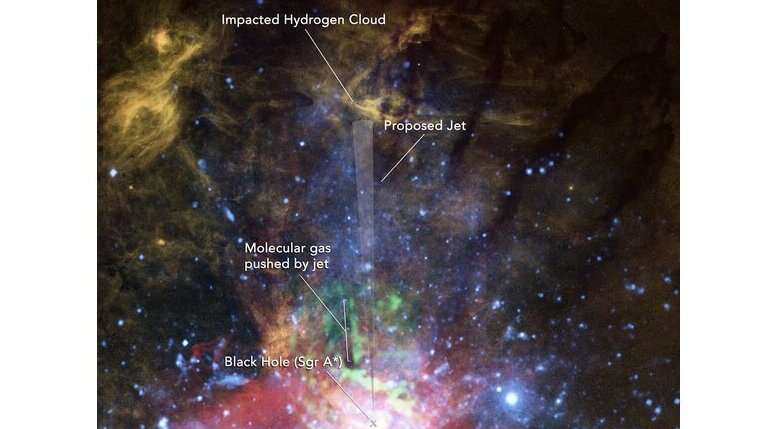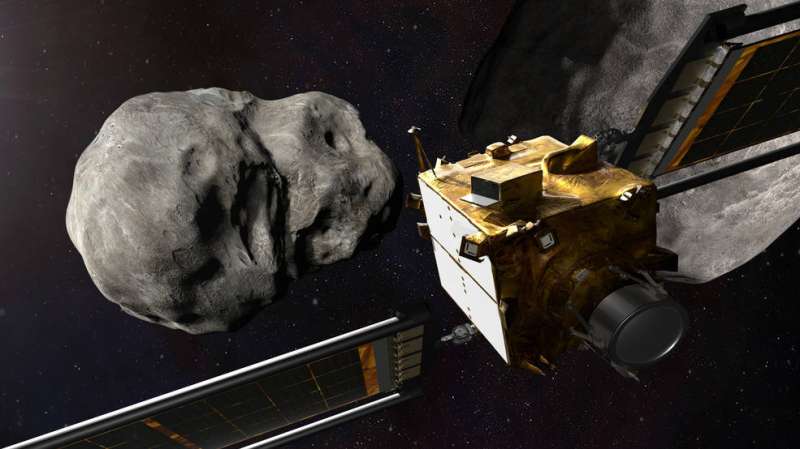
Copernical Team
NASA Goddard helps ensure asteroid deflector hits target
 Although the chance of an asteroid impacting Earth is small, even a relatively small asteroid of about 500 feet (about 150 meters) across carries enough energy to cause widespread damage around the impact site. NASA leads efforts in the U.S. and worldwide both to detect and track potentially hazardous asteroids and to study technologies to mitigate or avoid impacts on Earth.
If an asteroid
Although the chance of an asteroid impacting Earth is small, even a relatively small asteroid of about 500 feet (about 150 meters) across carries enough energy to cause widespread damage around the impact site. NASA leads efforts in the U.S. and worldwide both to detect and track potentially hazardous asteroids and to study technologies to mitigate or avoid impacts on Earth.
If an asteroid Sol 3320: Flexibility is Key
 Curiosity is currently located within "Maria Gordon notch," which is a rather tight canyon surrounded by high rock walls located at the transition onto the Greenheugh Pediment. Her views are currently magnificent - steep walls surround Curiosity and cast some rather dramatic shadows onto the workspace.
However, despite the beautiful views, today was a sobering lesson in the complexities of
Curiosity is currently located within "Maria Gordon notch," which is a rather tight canyon surrounded by high rock walls located at the transition onto the Greenheugh Pediment. Her views are currently magnificent - steep walls surround Curiosity and cast some rather dramatic shadows onto the workspace.
However, despite the beautiful views, today was a sobering lesson in the complexities of Kleos' Patrol Mission Satellites Ready and Shipped to Launch Site
 Kleos Space S.A, a space-powered Radio Frequency Reconnaissance data-as-a- service (DaaS) company, confirms its Patrol Mission (KSF2) satellites are on track to launch onboard the
Transporter-3 SpaceX mission in January 2022, successfully passing the final technical milestone with satellite builder Innovative Solutions In Space (ISISPACE).
The Patrol Mission satellites are travelling
Kleos Space S.A, a space-powered Radio Frequency Reconnaissance data-as-a- service (DaaS) company, confirms its Patrol Mission (KSF2) satellites are on track to launch onboard the
Transporter-3 SpaceX mission in January 2022, successfully passing the final technical milestone with satellite builder Innovative Solutions In Space (ISISPACE).
The Patrol Mission satellites are travelling Los Alamos National Laboratory awards satellite mission contract to NanoAvionics US
 Smallsat mission integrator NanoAvionics US has received a mission contract by Los Alamos National Laboratory (LANL), one of the largest science and technology institutions in the world. The 12U (1U equals 10 + 10 + 10 cm3) spacecraft, about the size of a microwave oven, will host the Mini Astrophysical MeV Background Observatory (MAMBO) mission.
The goal of MAMBO is to make the best-eve
Smallsat mission integrator NanoAvionics US has received a mission contract by Los Alamos National Laboratory (LANL), one of the largest science and technology institutions in the world. The 12U (1U equals 10 + 10 + 10 cm3) spacecraft, about the size of a microwave oven, will host the Mini Astrophysical MeV Background Observatory (MAMBO) mission.
The goal of MAMBO is to make the best-eve New rocket test facility under construction in Scotland
 The UK Space Agency welcomes the news that British company Orbex is constructing a state-of-the-art rocket test facility in Kinloss, Scotland.
Ian Annett, Deputy CEO of the UK Space Agency, said:
The construction of this new facility marks another major milestone in our ambitions to become a modern, agile spacefaring nation. Orbex is an innovative spaceflight company developing its o
The UK Space Agency welcomes the news that British company Orbex is constructing a state-of-the-art rocket test facility in Kinloss, Scotland.
Ian Annett, Deputy CEO of the UK Space Agency, said:
The construction of this new facility marks another major milestone in our ambitions to become a modern, agile spacefaring nation. Orbex is an innovative spaceflight company developing its o Redwire announces supplier agreement with Terran Orbital to support satellite manufacturing
 Redwire Corporation, a global leader in mission critical space infrastructure for the next generation space economy, has announced a three-year supplier agreement with Terran Orbital, a global leader and pioneer in the development, innovation and operation of small satellites and Earth observation solutions.
Through this agreement, Redwire will deliver a range of advanced components and so
Redwire Corporation, a global leader in mission critical space infrastructure for the next generation space economy, has announced a three-year supplier agreement with Terran Orbital, a global leader and pioneer in the development, innovation and operation of small satellites and Earth observation solutions.
Through this agreement, Redwire will deliver a range of advanced components and so Spire Global selects Virgin Orbit for late-load addition to next flight
 Leading launch company Virgin Orbit, which has announced a planned business combination with special purpose acquisition company NextGen Acquisition Corp. II, has announced alongside space-based data and analytics provider Spire Global, Inc. that they have received waiver approval from the Federal Aviation Authority to include Spire on Virgin Orbit's upcoming launch. The satellite, which was int
Leading launch company Virgin Orbit, which has announced a planned business combination with special purpose acquisition company NextGen Acquisition Corp. II, has announced alongside space-based data and analytics provider Spire Global, Inc. that they have received waiver approval from the Federal Aviation Authority to include Spire on Virgin Orbit's upcoming launch. The satellite, which was int Rocket Lab launches 109th satellite to orbit
 Rocket Lab USA, Inc. has successfully deployed two satellites to orbit for real-time geospatial intelligence company BlackSky, bringing the total number of satellites deployed by Rocket Lab to 109.
The 'A Data With Destiny' mission, arranged for BlackSky through global launch services provider Spaceflight Inc., was Electron's 23rd liftoff from Rocket Lab Launch Complex 1 on New Zealand's M
Rocket Lab USA, Inc. has successfully deployed two satellites to orbit for real-time geospatial intelligence company BlackSky, bringing the total number of satellites deployed by Rocket Lab to 109.
The 'A Data With Destiny' mission, arranged for BlackSky through global launch services provider Spaceflight Inc., was Electron's 23rd liftoff from Rocket Lab Launch Complex 1 on New Zealand's M Mini-jet found near Milky Way's supermassive black hole

Our Milky Way's central black hole has a leak. This supermassive black hole looks like it still has the vestiges of a blowtorch-like jet dating back several thousand years. NASA's Hubble Space Telescope hasn't photographed the phantom jet but has helped find circumstantial evidence that it is still pushing feebly into a huge hydrogen cloud and then splattering, like the narrow stream from a hose aimed into a pile of sand.
This is further evidence that the black hole, with a mass of 4.1 million Suns, is not a sleeping monster but periodically hiccups as stars and gas clouds fall into it. Black holes draw some material into a swirling, orbiting accretion disk where some of the infalling material is swept up into outflowing jets that are collimated by the black hole's powerful magnetic fields. The narrow "searchlight beams" are accompanied by a flood of deadly ionizing radiation.
"The central black hole is dynamically variable and is currently powered down," said Gerald Cecil of the University of North Carolina in Chapel Hill.
NASA Goddard helps ensure asteroid deflector hits target, predicts and will observe impact results

Although the chance of an asteroid impacting Earth is small, even a relatively small asteroid of about 500 feet (about 150 meters) across carries enough energy to cause widespread damage around the impact site. NASA leads efforts in the U.S. and worldwide both to detect and track potentially hazardous asteroids and to study technologies to mitigate or avoid impacts on Earth. If an asteroid were discovered and determined to be on a collision course with Earth, one response could be to launch a "kinetic impactor"—a high-velocity spacecraft that would deflect the asteroid by ramming into it, altering the asteroid's orbit slightly so that it misses Earth. NASA's Double Asteroid Redirection Test (DART) will be the first mission to demonstrate asteroid deflection using a kinetic impactor.
DART will test kinetic impactor technology by targeting a double asteroid that is not on a path to collide with Earth and therefore poses no actual threat to the planet.
